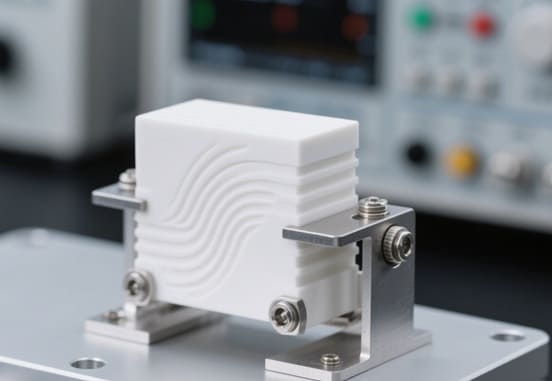Why Boron Nitride Ceramics Are Essential for High-Performance Thermal Management
Boron nitride ceramics, often called the “white graphite,” have gained significant attention as advanced ceramic materials for high-performance thermal management. Their unique combination of thermal conductivity, electrical insulation, chemical stability, and structural integrity makes them indispensable in industries ranging from electronics to aerospace. Unlike conventional ceramics, boron nitride provides both excellent heat dissipation and reliable insulation, a rare property pairing that addresses the growing demands of modern devices and systems. This article explores why boron nitride ceramics are essential, examining their properties, how they compare to other ceramics, and the practical benefits they bring to high-performance applications.
At Advanced Ceramics Hub, we specialize in high-quality boron nitride products, ensuring optimal performance for industrial and scientific applications.

What Is Boron Nitride and Why Is It Important in Thermal Management?
Boron nitride (BN) is a compound composed of boron and nitrogen, existing in multiple crystal structures such as hexagonal (h-BN), cubic (c-BN), and wurtzite (w-BN). Among these, hexagonal boron nitride is the most commonly used ceramic for thermal management due to its layered structure similar to graphite. Its ability to combine high thermal conductivity with electrical insulation makes it particularly valuable for electronic packaging, high-power devices, and thermal interface materials.
Key Forms of Boron Nitride Ceramics:
| Form | Structure | Key Feature | Typical Application |
| Hexagonal BN (H-BN) | Layered, graphite-like | High thermal conductivity + insulation | Heat sinks, substrates |
| Cubic BN (C-BN) | Diamond-like | Extreme hardness + stability | Cutting tools, abrasives |
| Wurtzite BN (W-BN) | Rare, metastable | Ultra-hard, rare | Research applications |
By combining these unique structures with advanced processing, boron nitride ceramics provide reliable solutions for industries where thermal control is mission-critical.
Explore our high-quality boron nitride products.
How Do the Thermal Properties of Boron Nitride Ceramics Compare to Other Materials?
Thermal management materials must balance conductivity, stability, and electrical properties. Metals like copper and aluminum conduct heat efficiently but lack electrical insulation. Conventional ceramics such as alumina (Al2O3) and aluminum nitride (AlN) offer insulation but vary in conductivity. Boron nitride stands out by achieving both high conductivity and strong dielectric performance, filling a gap in the material spectrum.
Comparison of Thermal Management Materials:
| Material | Thermal Conductivity (W/m·K) | Electrical Property | Thermal Stability |
| Copper | ~400 | Conductive | High |
| Aluminum | ~237 | Conductive | Moderate |
| Alumina (Al2O3) | ~20–30 | Insulator | High |
| Aluminum Nitride (AlN) | ~140–180 | Insulator | High |
| Boron Nitride (BN) | ~200 | Insulator | Very High |
As seen in the table, boron nitride bridges the gap between metals and ceramics, making it uniquely positioned for advanced thermal management systems.
Request a custom quote for boron nitride products.
What Makes Boron Nitride Ceramics Unique Among Advanced Ceramics?
Advanced ceramics like silicon nitride, zirconia, and alumina each bring different benefits. Silicon nitride is strong under mechanical stress, zirconia offers high toughness, and alumina provides broad cost-effectiveness. Boron nitride, however, combines high thermal conductivity, chemical inertness, and electrical insulation—an unusual trio of properties rarely found together in one material.
Comparison of Advanced Ceramic Materials:
| Ceramic Material | Key Strength | Limitation | Common Use |
| Alumina (Al2O3) | Cost-effective, insulating | Lower thermal conductivity | Substrates, insulators |
| Zirconia (ZrO2) | High toughness | Limited conductivity | Medical implants, tools |
| Silicon Nitride (Si3N4) | High strength, shock resistance | Complex processing | Bearings, engine parts |
| Boron Nitride (BN) | Conductive + insulating balance | Higher cost | Thermal management, aerospace |
This balance of properties makes boron nitride ceramics especially attractive for industries pushing the limits of miniaturization and heat dissipation.
In Which Applications Do Boron Nitride Ceramics Excel in Thermal Management?
Boron nitride ceramics are applied wherever efficient heat transfer and electrical safety are required simultaneously. Their ability to perform under extreme conditions ensures reliable operation in electronics, energy systems, and aerospace technologies.
Main Applications of Boron Nitride Ceramics:
- Electronics packaging: Heat sinks and substrates for power devices
- Aerospace components: Thermal shielding in spacecraft and jet engines
- Energy systems: Thermal management in fuel cells and power modules
- High-temperature furnaces: Crucibles, insulators, and liners
- Medical equipment: Safe and stable thermal interfaces in devices
Each of these applications benefits from boron nitride’s balance of conductivity and insulation, reducing failure risks caused by overheating.
How Does Boron Nitride Ceramic Improve Electronic Thermal Management?
The rapid miniaturization of electronics creates higher power densities and localized heating. Traditional materials often fail to meet these challenges, either conducting heat but risking short-circuits, or insulating but retaining heat. Boron nitride ceramics offer a unique solution.
Benefits of BN in Electronics:
| Factor | Conventional Material Issue | BN Ceramic Solution |
| Heat dissipation | Metals conduct but lack insulation | BN combines conductivity + insulation |
| Electrical reliability | Conductive substrates risk shorting | BN provides dielectric strength |
| Longevity | Heat cycling reduces performance | BN withstands thermal shocks |
By integrating boron nitride into substrates and packaging, electronic devices can operate more efficiently and with longer service life.
Why Are Boron Nitride Ceramics Preferred in High-Temperature Applications?
Many thermal management materials degrade under extreme heat, losing strength, conductivity, or chemical resistance. Boron nitride ceramics, however, remain stable at temperatures exceeding 1000°C in inert or vacuum conditions. Their resistance to reacting with molten metals and corrosive environments further broadens their usability.
High-Temperature Application Advantages:
- Withstands >1000°C without degradation
- Chemically inert to molten metals (Fe, Al, Cu, etc.)
- Provides reliable insulation in plasma and arc systems
- Maintains structural integrity under thermal shock
These properties ensure boron nitride ceramics perform consistently in furnaces, aerospace propulsion, and energy generation.
How Do Boron Nitride Ceramics Compare to Competing Thermal Management Materials?
When selecting thermal management solutions, engineers must balance performance and cost. Boron nitride ceramics are more expensive than alumina but provide higher performance where reliability is critical. Compared to aluminum nitride, BN often offers better dielectric properties and resistance to thermal shock.
Material Selection Guide for Thermal Management:
| Material | Cost | Conductivity | Dielectric Strength | Suitability |
| Alumina | Low | Moderate | High | General applications |
| Aluminum Nitride | Medium | High | Moderate | Electronics packaging |
| Boron Nitride | Higher | Very High | Very High | High-performance systems |
Thus, boron nitride ceramics are essential where system failure is not an option and reliability outweighs material cost.
What Are the Future Trends for Boron Nitride in Thermal Management?
As devices grow more compact and powerful, thermal management materials must evolve. Boron nitride ceramics are increasingly being engineered into composites, coatings, and hybrid structures to optimize performance. Ongoing research also explores nanostructured BN for next-generation heat spreaders and thermal interface materials.
Emerging Trends for BN Ceramics:
- Development of BN-polymer composites for lightweight solutions
- Use of nano-BN fillers in thermal interface materials (TIMs)
- Advanced coatings for aerospace thermal barriers
- Integration into 5G and high-frequency electronics packaging
These innovations position boron nitride ceramics at the forefront of future thermal management strategies.
FAQ
| Question | Answer |
| Is boron nitride electrically conductive? | No, boron nitride is an excellent electrical insulator while conducting heat efficiently. |
| How hot can boron nitride ceramics get? | Hexagonal BN remains stable above 1000°C in inert atmospheres. |
| Can boron nitride ceramics be machined? | Yes, they are easily machinable compared to many other ceramics. |
| Where is boron nitride used most? | Electronics, aerospace, high-temperature furnaces, and energy systems. |
| How does boron nitride compare to aluminum nitride? | BN generally offers better dielectric strength and thermal shock resistance. |
Conclusion
Boron nitride ceramics stand out as one of the most effective materials for high-performance thermal management. Their rare combination of high thermal conductivity, electrical insulation, and chemical stability makes them uniquely capable of meeting the challenges of modern electronics, aerospace, and high-temperature systems. Compared with other advanced ceramics, boron nitride achieves a balance that ensures both efficiency and reliability. As technology advances, the role of boron nitride ceramics will only expand, shaping the future of high-performance thermal management across industries.
Looking for high-quality boron nitride products? Contact us today!
